CSS3 结构性伪类选择器(1)
1.CSS3 结构性伪类选择器—root
:root选择器就是匹配元素E所在文档的根元素。在HTML文档中,根元素始终是<html>。
“:root”选择器等同于<html>元素,简单点说:
:root{background:orange}
html {background:orange;}
示例演示:
通过“:root”选择器设置背景颜色
HTML代码:
<div>:root选择器的演示</div>
CSS代码:
:root {
background:orange;
}
演示结果:

“:root”选择器等同于<html>元素,简单点说:
:root{background:orange}
html {background:orange;}
得到的效果等同。
建议使用:root方法。
:root 代码示例:
<!DOCTYPE html>
<html>
<head>
<meta charset="utf-8">
<title>结构性伪类选择器—root</title> <style type="text/css">
:root{
background: skyblue;
color: blue;
} </style>
</head>
<body>
<div>Root选择器修改HTML元素的背景颜色</div>
</body>
</html>
效果:
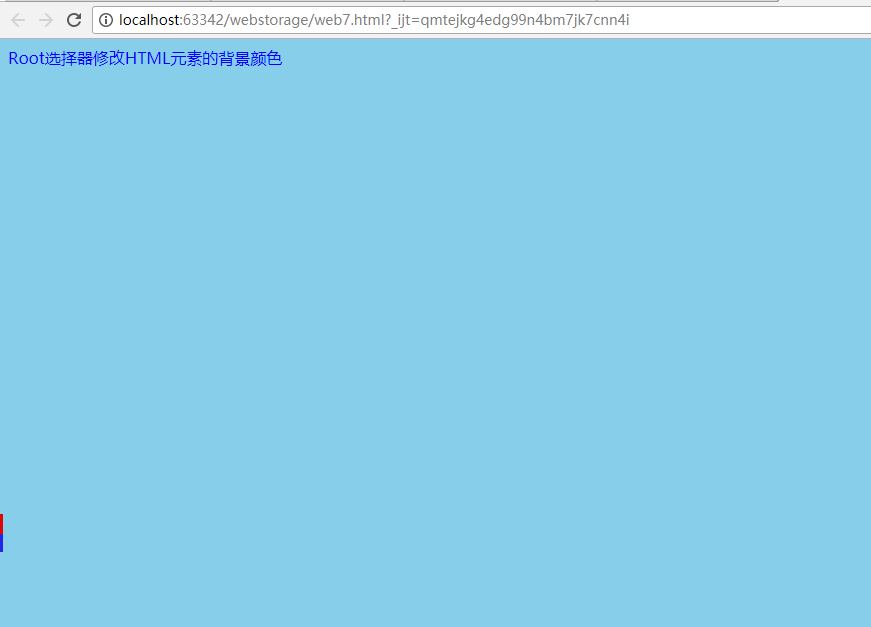
html 代码示例:
<!DOCTYPE html>
<html>
<head>
<meta charset="utf-8">
<title>结构性伪类选择器—root</title> <style type="text/css">
html{
background: rebeccapurple;
color: blue;
} </style>
</head>
<body>
<div>Root选择器修改HTML元素的背景颜色</div>
</body>
</html>
效果:
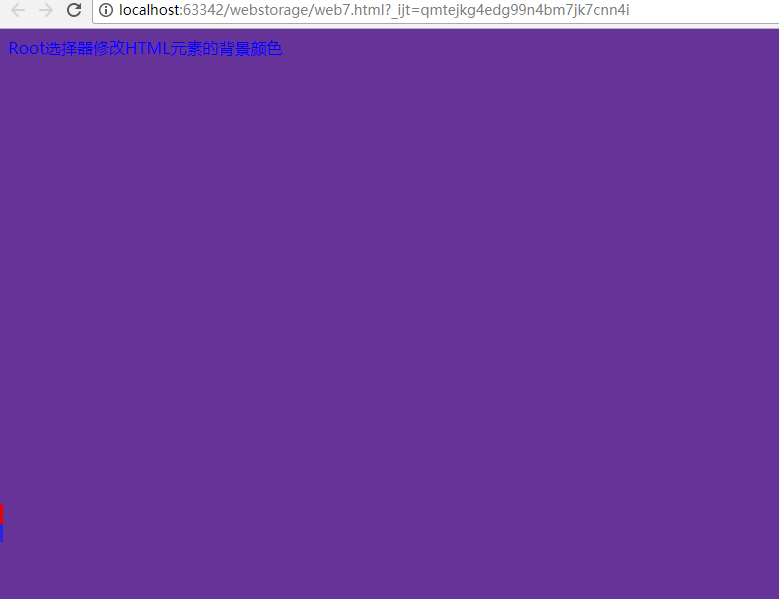
2.:not选择器称为否定选择器
:not选择器称为否定选择器,和jQuery中的:not选择器一模一样,可以选择除某个元素之外的所有元素。就拿form元素来说,比如说你想给表单中除submit按钮之外的input元素添加红色边框,CSS代码可以写成:
form {
width: 200px;
margin: 20px auto;
}
div {
margin-bottom: 20px;
}
input:not([type="submit"]){
border:1px solid red;
}
相关HTML代码:
<form action="#">
<div>
<label for="name">Text Input:</label>
<input type="text" name="name" id="name" placeholder="John Smith" />
</div>
<div>
<label for="name">Password Input:</label>
<input type="text" name="name" id="name" placeholder="John Smith" />
</div>
<div>
<input type="submit" value="Submit" />
</div>
</form>
演示结果:
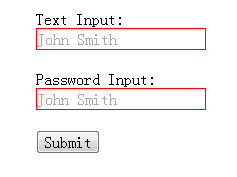
代码示例:
<!DOCTYPE html>
<html>
<head>
<meta charset="utf-8">
<title>结构性伪类选择器—not</title> <style type="text/css">
div{
padding: 10px ;
width:200px; }
div:not([id="footer"]){
background: orange;
}
li{
background: skyblue;
width:250px;
}
li:not([id="class2"] ){
background: slateblue;
}
</style> </head>
演示结果:
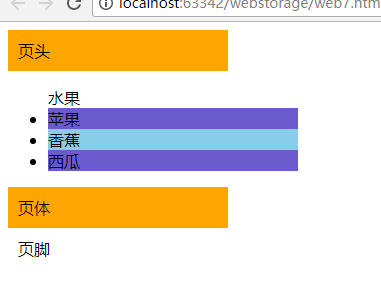
3.CSS3 结构性伪类选择器—empty
:empty选择器表示的就是空。用来选择没有任何内容的元素,这里没有内容指的是一点内容都没有,哪怕是一个空格。
示例显示:
比如说,你的文档中有三个段落p元素,你想把没有任何内容的P元素隐藏起来。我们就可以使用“:empty”选择器来控制。
HTML代码:
<p>我是一个段落</p>
<p> </p>
<p></p>
CSS代码:
p{
background: orange;
min-height: 30px;
}
p:empty {
display: none;
}
演示结果:
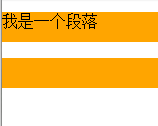
代码示例:
<!DOCTYPE html>
<html>
<head>
<meta charset="utf-8">
<title>结构性伪类选择器—empty</title>
<style type="text/css">
div {
background: blueviolet;
min-height: 30px;
width: 200px;
}
div:empty {
border: 1px dashed red;
background: skyblue;
}
</style>
</head>
<body>
<div>我这里有内容</div>
<div> <!-- 我这里有一个空格 --></div>
<div></div><!-- 我这里任何内容都没有 -->
</body>
</html>
演示结果:

4.CSS3 结构性伪类选择器—target
:target选择器称为目标选择器,用来匹配文档(页面)的url的某个标志符的目标元素。我们先来上个例子,然后再做分析。
示例展示
点击链接显示隐藏的段落。
HTML代码:
<h2><a href="#brand">Brand</a></h2>
<div class="menuSection" id="brand">
content for Brand
</div>
CSS代码:
.menuSection{
display: none;
}
:target{/*这里的:target就是指id="brand"的div对象*/
display:block;
}
演示结果:
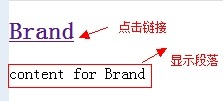
分析:
1、具体来说,触发元素的URL中的标志符通常会包含一个#号,后面带有一个标志符名称,上面代码中是:#brand
2、:target就是用来匹配id为“brand”的元素(id="brand"的元素),上面代码中是那个div元素。
多个url(多个target)处理:
就像上面的例子,#brand与后面的id="brand"是对应的,当同一个页面上有很多的url的时候你可以取不同的名字,只要#号后对的名称与id=""中的名称对应就可以了。
如下面例子:
html代码:
<h2><a href="#brand">Brand</a></h2>
<div class="menuSection" id="brand">
content for Brand
</div>
<h2><a href="#jake">Brand</a></h2>
<div class="menuSection" id="jake">
content for jake
</div>
<h2><a href="#aron">Brand</a></h2>
<div class="menuSection" id="aron">
content for aron
</div>
css代码:
#brand:target {
background: orange;
color: #fff;
}
#jake:target {
background: blue;
color: #fff;
}
#aron:target {
background: red;
color: #fff;
}
上面的代码可以对不同的target对象分别设置不的样式。
代码示例:
<!DOCTYPE html>
<html>
<head>
<meta charset="UTF-8">
<title>target demo</title>
<style type="text/css">
div:target{
background: purple;border: 1px solid black;
}
</style>
</head>
<body>
<ul>
<li><a href="#tab1">tab1</a></li>
<li><a href="#tab2">tab2</a></li>
<li><a href="#tab3">tab3</a></li>
<li><a href="#tab4">tab4</a></li>
</ul>
<div id="tab1">this is tab1</div>
<div id="tab2">this is tab2</div>
<div id="tab3">this is tab3</div>
<div id="tab4">this is tab4</div>
</body>
</html>
演示结果:
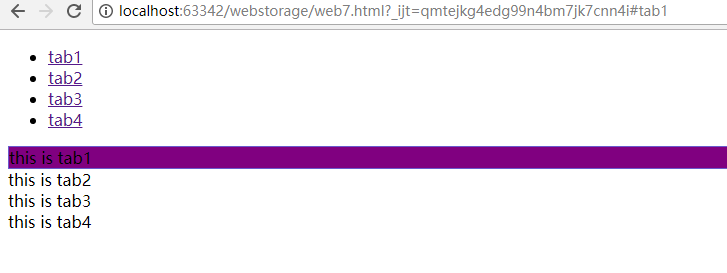
转载:http://www.imooc.com/code/736
CSS3 结构性伪类选择器(1)的更多相关文章
- Atitit.隔行换色 变色 css3 结构性伪类选择器
Atitit.隔行换色 变色 css3 结构性伪类选择器 1.1. css3隔行换色扩展阅读 1 1.2. 结构伪选择器 1 1.3. jQuery 选择器2 1.1. css3隔行换色扩展阅读 原 ...
- CSS3 结构性伪类选择器(2)
CSS3 结构性伪类选择器—first-child “:first-child”选择器表示的是选择父元素的第一个子元素的元素E.简单点理解就是选择元素中的第一个子元素,记住是子元素,而不是后代元素. ...
- css3 结构性伪类选择器
伪类 选择器 类型 说明 备注 E:first-line 伪元素选择器 选择匹配E元素内的第一行文本 E:first-letter 伪元素选择器 选择匹配E元素内的第一个字符 E:before 伪元素 ...
- css3结构性伪类选择器
- h5与c3权威指南笔记--css3结构性伪类选择器root,not,empty,target
root:将样式绑定到根元素(html中的根元素是<html></html>) 举个栗子 :root{ background-color: yellow; } body{ ba ...
- CSS3每日一练之选择器-结构性伪类选择器
<!DOCTYPE HTML> <html> <head> <meta charset="gb2312"> <title> ...
- 【CSS3】---结构性伪类选择器—nth-child(n)+nth-last-child(n)
结构性伪类选择器—nth-child(n) “:nth-child(n)”选择器用来定位某个父元素的一个或多个特定的子元素.其中“n”是其参数,而且可以是整数值(1,2,3,4),也可以是表达式(2n ...
- 【CSS3】---结构性伪类选择器-first-child+last-child
结构性伪类选择器—first-child “:first-child”选择器表示的是选择父元素的第一个子元素的元素E.简单点理解就是选择元素中的第一个子元素,记住是子元素,而不是后代元素. 示例演示 ...
- 【CSS3】---结构性伪类选择器-root+not+empty+target
结构性伪类选择器—root :root选择器,从字面上我们就可以很清楚的理解是根选择器,他的意思就是匹配元素E所在文档的根元素.在HTML文档中,根元素始终是<html>. 示例演示: 通 ...
随机推荐
- JavaScript公共库event-stream被植入恶意代码
[安全预警]JavaScript公共库event-stream被植入恶意代码 2018年11月27日,阿里云云盾应急响应中心监测到JavaScript公共库event-stream被植入恶意代码,该恶 ...
- Anyhashable打印格式化
NSLog("<LocalContactMatch>: \(bestAttemptContent.userInfo as AnyObject)")
- React-Native 之 GD (六)无数据情况处理
1.还是网络问题,在网络出现问题或者无法加载数据的时候,一般我们会展示空白页,在空白页中提示 无数据 之类的提示,比较好的还会使用 指示器 的方式告诉用户网络出现问题等等. 这边我们做以下处理,当无数 ...
- PHP 设计模式总结
回想了一下php的设计模式,好像记得不完全了.此处对php设计模式重新做一下复习总结. 单例模式 单例模式的核心只包括一个特殊的类,保证系统中只能有一个实例,即一个类中只能有一个实例化对象,避免系统中 ...
- (转)sql server 事务与try catch
本文转载自:http://www.cnblogs.com/sky_Great/archive/2013/01/09/2852417.html sql普通事务 begin transaction tr ...
- 阶段1 语言基础+高级_1-3-Java语言高级_1-常用API_1_第4节 ArrayList集合_14-ArrayList集合的常用方法和循环
常用的方法记下来 刚创建好,什么都不放的 add添加方法肯定是成功的. 加了这么多的值都没有用返回值,输出的结果可以看到都是添加成功的 获取索引值 ALT+回车键,推荐使用本地变量去接收 这样左边就会 ...
- 测开之路一百一十一:bootstrap表单
bootstrap表单 引入bootstrap和jquery 默认表单 垂直表单 表单属性绑定:for属性,当for的属性和id的属性相同时,单击for标签,光标自动跳到相同属性的输入框 复选框 水平 ...
- C#线程中安全访问控件(重用委托,避免繁复的delegate,Invoke)总结
1.第一种,不安全,当线程过多后,timer控件和线程中同时访问窗体控件时,有时会出现界面重绘出错. public frmMain() { InitializeComponent(); System. ...
- POI向Excel中写入数据及追加数据
import org.apache.poi.xssf.usermodel.XSSFCell; import org.apache.poi.xssf.usermodel.XSSFRow; import ...
- 前端表格选中列合计,select-chosen,set集合,display隐藏
业务涉及到table选中列合计,同时隐藏未选中列.为了减少后端请求数据,前端获得所有数据后筛选计算. 1.select下拉框初始化 $(function() { $('.chosen-select') ...
